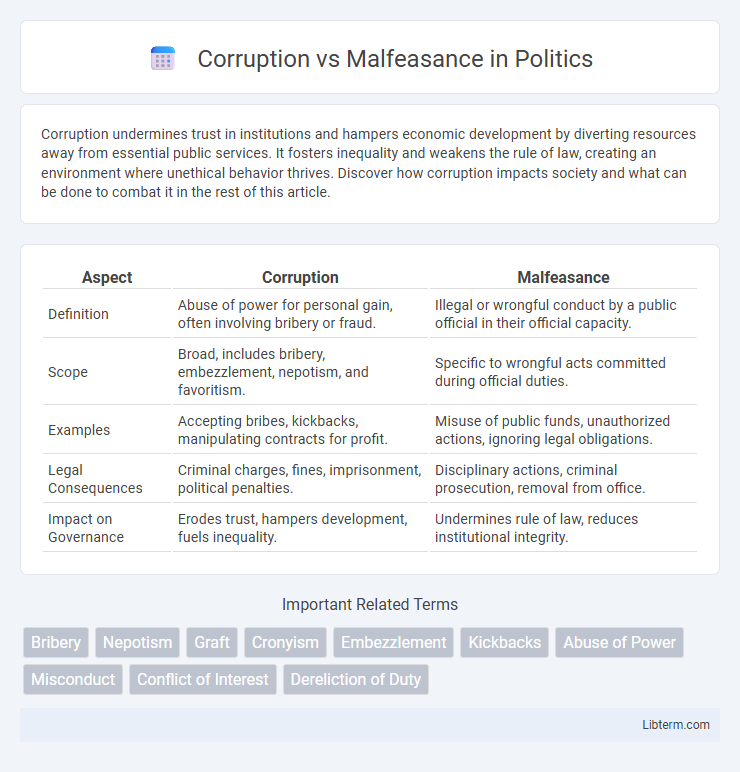Corruption undermines trust in institutions and hampers economic development by diverting resources away from essential public services. It fosters inequality and weakens the rule of law, creating an environment where unethical behavior thrives. Discover how corruption impacts society and what can be done to combat it in the rest of this article.
Table of Comparison
| Aspect | Corruption | Malfeasance |
|---|---|---|
| Definition | Abuse of power for personal gain, often involving bribery or fraud. | Illegal or wrongful conduct by a public official in their official capacity. |
| Scope | Broad, includes bribery, embezzlement, nepotism, and favoritism. | Specific to wrongful acts committed during official duties. |
| Examples | Accepting bribes, kickbacks, manipulating contracts for profit. | Misuse of public funds, unauthorized actions, ignoring legal obligations. |
| Legal Consequences | Criminal charges, fines, imprisonment, political penalties. | Disciplinary actions, criminal prosecution, removal from office. |
| Impact on Governance | Erodes trust, hampers development, fuels inequality. | Undermines rule of law, reduces institutional integrity. |
Defining Corruption and Malfeasance
Corruption refers to the abuse of entrusted power for private gain, often involving bribery, nepotism, or embezzlement within public or private sectors. Malfeasance denotes the commission of an intentional act that is unlawful or wrongful, especially by a public official in the execution of their duties. Distinguishing these terms is crucial for legal and ethical accountability, with corruption emphasizing illicit gain and malfeasance focusing on wrongful conduct.
Historical Contexts of Corruption and Malfeasance
Historical contexts of corruption and malfeasance reveal patterns of abuse of power across civilizations, from ancient empires to modern states. Corruption often involved bribery and nepotism undermining governance, while malfeasance referred to wrongful acts by public officials violating legal or ethical duties. Understanding these distinctions in historical frameworks highlights how misappropriation of authority has shaped political and social developments worldwide.
Key Differences Between Corruption and Malfeasance
Corruption involves the abuse of power for personal gain, often through bribery, embezzlement, or nepotism, impacting public trust and governance integrity. Malfeasance refers specifically to wrongdoing or illegal actions by a public official or professional within their official capacity, such as fraud or misconduct. The key difference lies in corruption being a broader concept encompassing systemic unethical practices, while malfeasance is a direct illegal act committed by an individual in authority.
Common Forms of Corruption in Governance
Common forms of corruption in governance include bribery, nepotism, embezzlement, and favoritism, which undermine public trust and hinder effective policy implementation. These corrupt practices divert resources away from essential public services and distort decision-making processes for personal gain. Malfeasance, while a broader term referring to wrongful or illegal conduct by public officials, often manifests through these corrupt activities, damaging institutional integrity and accountability.
Malfeasance in Public Office: Examples and Cases
Malfeasance in public office refers to the willful misconduct or wrongful actions taken by government officials in the course of their duties, often involving abuse of power or violation of legal obligations. Notable examples include the extrajudicial killings connected to former Chicago Mayor Richard J. Daley's administration and the misuse of funds during South Korea's 2016 scandal involving President Park Geun-hye. These cases highlight systemic breaches that undermine public trust and legal standards, distinguishing malfeasance from broader corruption by its explicit legal and ethical breaches within public office functions.
Legal Frameworks Addressing Corruption vs Malfeasance
Legal frameworks addressing corruption primarily focus on preventing and penalizing bribery, embezzlement, and abuse of public office, often through anti-corruption agencies and transparency laws. In contrast, malfeasance, which involves the wrongful or illegal conduct by a public official, is typically prosecuted under criminal and administrative law statutes that emphasize breach of duty and official misconduct. Anti-corruption laws such as the Foreign Corrupt Practices Act (FCPA) and the United Nations Convention against Corruption (UNCAC) provide comprehensive mechanisms for tackling corruption, while malfeasance cases rely on jurisdiction-specific legal provisions to uphold accountability in government operations.
Societal Impact of Corruption and Malfeasance
Corruption erodes public trust and undermines governmental institutions, leading to increased poverty and social inequality by diverting resources meant for public services. Malfeasance, characterized by wrongful or unlawful conduct by officials, compromises ethical standards and exploits power for personal gain, weakening legal frameworks and accountability. Both phenomena distort economic development and perpetuate societal instability by fostering a culture of impunity and inefficiency.
Detection and Prevention Strategies
Detection of corruption relies heavily on whistleblower systems, financial audits, and data analytics to identify irregular transactions and unethical behavior. Malfeasance detection often involves forensic accounting and legal investigations targeting specific breaches of duty or illegal acts by officials. Prevention strategies include robust internal controls, transparency initiatives, ethical training programs, and strict enforcement of anti-corruption laws to mitigate opportunities for both corruption and malfeasance.
International Perspectives on Corruption and Malfeasance
International perspectives on corruption and malfeasance emphasize the distinction where corruption broadly includes bribery, embezzlement, and nepotism undermining governance, while malfeasance specifically refers to wrongful or illegal conduct by public officials. Global organizations such as Transparency International and the United Nations Office on Drugs and Crime track corruption indices and promote anti-malfeasance measures to enhance accountability across jurisdictions. Cross-national efforts prioritize legal frameworks, enforcement mechanisms, and public sector reforms to combat both corruption and malfeasance effectively in diverse political and economic contexts.
Future Challenges and Solutions
Future challenges in combating corruption and malfeasance include the increasing complexity of global financial networks and the rise of digital currencies, which complicate tracking illicit transactions. Strengthening international cooperation through enhanced legal frameworks and real-time data sharing can improve enforcement effectiveness. Implementing advanced technologies such as AI-driven monitoring systems will help detect irregularities early and promote transparency across sectors.
Corruption Infographic

 libterm.com
libterm.com